Prompt engineering arose because current large language models (LLMs) present us with a primitive interface: text goes in, text comes out. In software architecture, we call this "incidental coupling": a fragile dependency created by an immature interface. These couplings are always temporary, eventually refactored away into more robust, intuitive systems.
Here's how this refactoring is already beginning for LLMs:
Function calls & tool invocation: Models increasingly communicate through structured data (JSON APIs) rather than conversational text.
Embedded vector memory: Models store context internally, recalling relevant information without explicit prompting.
Multimodal interfaces: AI that processes audio, video, cursor movements, gestures, and even eye gaze—eliminating the need for explicit text-based prompts.
As interfaces evolve to automatically infer context from real-world signals (your cursor movements, eye gaze, and calendar events) explicit prompting fades away.
The Role of AGI: Self-Prompting Systems

Paul Graham has pointed out that true artificial general intelligence (AGI) would eliminate the need for carefully crafted prompts altogether. AGI systems will prompt themselves, dynamically optimising their queries and interactions. Today’s detailed prompt crafting is a temporary workaround, bridging the gap until AI reaches a level of intuitive interaction and self-driven understanding.
This aligns closely with J.C.R. Licklider's vision of "man-computer symbiosis," proposed back in 1960; he envisions a world where computers proactively anticipate and respond to our needs without explicit instructions. Today’s manually engineered prompts are like batch-processing punch cards, a primitive step on the path to genuine symbiosis.
The Evolutionary Path of Prompting
Historically, manual, repetitive tasks in technology always get abstracted and automated. In the early web, development was manual HTML coding; this later was largely replaced by platforms like WordPress and Wix.
In the case of prompt engineering, we will see a similar but accelerated path:
Gold Rush (2023–2025): High salaries and rapid growth in prompt libraries. Templatisation (2025–2026): Tools automatically optimizing and generating effective prompts. Abstraction (2026–2028): Emergence of intuitive, structured interfaces where explicit prompting becomes unnecessary. Obsolescence (2028–2030): Prompt engineering remains only for niche, specialised scenarios.
Where True Value Lies: Context and Ecotones
In the long run, prompts aren't a sustainable competitive advantage. The critical area for long-term value creation is the AI "ecotone," the dynamic interface zone between humans and AI systems: value shifts toward context and continuous feedback. For example:
Proprietary datasets: Unique insights and information unavailable to competitors. Real-time feedback loops: Continuous, immediate learning from user interactions, moving beyond static prompt-response. Human context and norms: Compliance, ethics, brand personality—qualities impossible to encode fully in simple text instructions.
Where to Place Your Career Bets
As prompt engineering becomes automated, three roles will emerge as high-value alternatives:
- Interface Architects: Design the seamless AI touch-points where humans and systems meet, requiring UX expertise and technical knowledge.
- Data Ecologists/Ethicists: Create and maintain the living datasets that feed AI systems, focusing on quality, ethics, and continuous improvement.
- Context Specialists: Translate domain-specific knowledge (legal, medical, financial) into AI-ready frameworks that machines can learn from.
The prompt engineers who thrive long-term won't be the ones crafting perfect instructions—they'll be the ones building the systems that make instructions unnecessary.
Prompt engineering isn't snake oil; it's scaffolding that is necessary at the start of the build. Get paid for it today if you can, but build your expertise in the layers that cannot be automated away: domain knowledge, ethical frameworks, and human-AI feedback systems. Because by 2030, the only people still writing prompts will be maintaining legacy systems while innovation happens higher up the stack.
